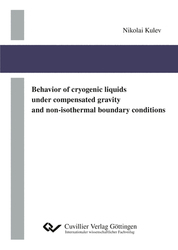| Areas | |
|---|---|
| Serie de libros (96) |
1379
|
| Nachhaltigkeit |
3
|
| Gesundheitswesen |
1
|
| Letra |
2367
|
| Ciencias Naturales |
5407
|
| Ciencias Ingeniería |
1793
|
| Ingeniería | 292 |
| Ingeniería mecánica y de proceso | 862 |
| Ingeniería eléctrica | 686 |
| Mineria y metalurgía | 30 |
| Arquitectura e ingeniería civil | 75 |
| General |
98
|
|
Leitlinien Unfallchirurgie
5. Auflage bestellen |
|
Erweiterte Suche
Behavior of cryogenic liquids under compensated gravity and non-isothermal boundary conditions (Tienda española)
Nikolai Kulev (Autor)Previo
Indice, PDF (510 KB)
Lectura de prueba, PDF (750 KB)
This study deals with the investigation regarding the behavior of liquid cryogenic propellants in the launcher upper stages under microgravity with superheated tank walls. It contributes in this way to the application-oriented basic research by describing mathematically and quantifying experimentally the influence of evaporation on the interface reorientation of cryogenic liquids. In broader terms this work shows, both in a mathematical and an experimental way, the influence of the heat and mass transfer in the fluid and solid phases on the linear momentum transfer in the liquid phase due to the coupling of the transfer mechanisms.
The main assumption behind this study is based on the principle that the solution of a partial differential equation depends on its boundary condition. In this case these are the mass balance boundary conditions at the interface and the contact line. These boundary conditions relate the respective liquid and the interface velocities to the mass flux due to interfacial evaporation, or phase change in general. A mathematical description of the reorientation was developed implementing an equation for the contact line boundary condition which takes explicitly into account the evaporation or the wall superheat at the contact line, respectively. Both the contact line velocity and the contact line angle become functions of the evaporation at the contact line and accordingly of the related dimensionless numbers. The implementation of the contact line boundary condition completes the equation system describing the non-isothermal flow macroscopically. A joint scaling approach of all field equations and boundary conditions was developed through which the influence of evaporation on the capillary-driven motion was expressed mathematically. This influence on the motion of the whole interface was experimentally quantified, too. For that purpose cryogenic liquids were used in drop tower experiments at ZARM, University of Bremen, with varying wall temperature gradients above the liquid-vapor interface. The experiments present the first experimental investigation of the reorientation of cryogenic liquids under non-isothermal boundary conditions.
The characteristics of the interface motion were found to vary in dependence on the dimensionless numbers related to evaporation arising from the above mentioned two boundary conditions, especially at the contact line. Thus the variation of the interface dynamics during the reorientation, e.g. an increase of both the oscillation frequency of the interface center point and of the mean velocity of the contact line after its initial transient rise, is attributed to the variation of evaporation. In contrast the influence of capillarity as a driving mechanism of the reorientation remains practically the same.
| ISBN-13 (Impresion) | 9783736971523 |
| ISBN-13 (E-Book) | 9783736961524 |
| Formato | A5 |
| Idioma | Inglés |
| Numero de paginas | 172 |
| Laminacion de la cubierta | mate |
| Edicion | 1. |
| Lugar de publicacion | Göttingen |
| Lugar de la disertacion | Bremen |
| Fecha de publicacion | 04.02.2020 |
| Clasificacion simple | Tesis doctoral |
| Area |
Ingeniería
Mecánica de medida Ingeniería mecánica y de proceso Ingeniería aeroespacial |
| Palabras claves | cryogenic liquids, interface reorientation, interface oscillations, capillary-driven flow, contact line motion, contact line boundary condition, interfacial phase change, evaporation, interface dynamics, drop tower experiments, microgravity, wall superheat, non-isothermal, boundary conditions, launcher upper stages, scaling, ballistic phase, dynamic contact angle, propellant tanks, competition between capillarity and evaporation, interfacial flow, sloshing, coupling of linear momentum, heat and mass transfer |








